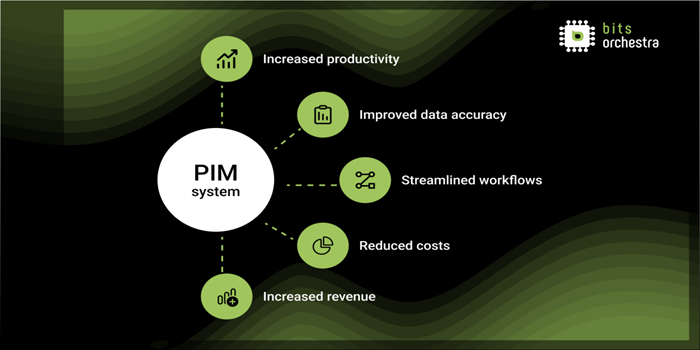Product information system for e-commerce store: benefits and solutions
With the tremendous triumph of the internet commerce in recent decades, the maintenance of product information has become increasingly tedious for people to support. This struggle had led to the development of Product Information Management systems or (PIM) software. By implementing a PIM solution, you can create and deliver compelling product experiences faster and easier than ever before.
What is a PIM System?
A PIM system is a software solution that enables businesses to create, manage, and distribute product information across multiple channels. PIM software provides a centralized platform for organizations to store, manage, and share product information. PIM (Product Information Management) systems help businesses to efficiently manage product information such as product descriptions, pricing, images and technical specifications. Using PIM systems, businesses can easily create and maintain product catalogs, product hierarchies, and ensure the quality of product data.
With PIM it becomes easier to keep track of product information and create a streamlined experience across all sales channels. Additionally, PIM systems can integrate with various data sources, such as ERPs, CRMs, and eCommerce platforms, making it easy to collect, manage, and distribute data across different channels.
-
Centralized Product Information Management: PIM systems allow businesses to quickly and easily manage product data in one central location. This makes it easier to ensure accuracy and consistency across all channels, as well as providing the ability to quickly update product information in one place and have it reflected across all channels. Additionally, PIM systems provide an easy way to ensure data is compliant with industry regulations and standards.
-
Improved Data Quality: PIM systems can help to improve customer experiences and the overall efficiency of a business. By ensuring product information is consistent, accurate, and up-to-date, customer experiences are improved, errors are reduced, and the onboarding process is streamlined. With this assurance, businesses can be certain that their customers are receiving the most up-to-date product information, as well as the best customer experience possible.
-
Faster Time to Market: Product Information Management (PIM) systems are a valuable tool for businesses, allowing them to quickly and easily create and distribute product information across multiple channels. This reduces the amount of time it takes to launch new products and make changes to existing products, making it easier to keep up with the constantly evolving demands of the market.
-
Increased Productivity: Product Information Management (PIM) systems eliminate the need for manual data entry, resulting in fewer human errors and freeing up staff to focus on more important tasks. Additionally, by consolidating all data into one centralized platform, businesses can quickly and accurately access and update data, as well as reduce the time and effort it takes to manage product information.
-
Improved Customer Experience: PIM helps to reduce errors and improve data quality. This, in turn, leads to more efficient processes, better customer service, and improved customer satisfaction. Furthermore, having accurate and up-to-date product information allows businesses to provide customers with consistent and accurate product information across all channels, which is essential for creating a positive customer experience.
Importance of PIM System in Today's Business Landscape
PIM systems are critical for businesses to stay ahead of the competition in today's fast-paced business environment. With PIM, businesses can launch new products quickly and promptly make changes to existing products. Additionally, by centralizing product information management, businesses can improve data quality, increase productivity, and provide better customer experiences.
By connecting the PIM system with other software, businesses can automate product information management tasks, save time and resources, and ensure a consistent flow of product data. Furthermore, integrating a PIM system can make it easier for businesses to launch new products on multiple marketplaces and keep their product listings up-to-date.
Important:
When integrating a PIM system, it is important to consider the specific needs of the business. It is critical to ensure that the PIM system is compatible with other applications and can handle the complexity of product data.
Businesses can benefit from the integration of PIM systems in a variety of ways, including:
-
Improved data quality and consistency: Implementing a PIM system as part of the overall business process that, in conjunction with other tools and applications, allows data about products to be accurate, consistent, and up-to-date across all channels.
-
Increased efficiency and productivity:
In order to reduce errors in data management, businesses can centralize product data and automate data management processes. The use of PIMs also saves time and reduces the risk of duplication. -
Faster time-to-market:
In order to quickly launch new products and update existing products, businesses can benefit from a PIM system that is integrated with other tools. With automated data entry, businesses can reduce the delays caused by manual data entry and inconsistencies in data, resulting in time and cost savings. -
Enhanced customer experience: By providing accurate and consistent product data across all channels, businesses have the opportunity to provide their customers with relevant and personalized information about their products, which will improve the overall customer experience.
-
Greater scalability: As a business grows and expands into new markets or sales channels, the integration of the PIM system will make it easier to scale and adapt the system to the needs of the business as they change.
For whom PIM system is good to develop?
A PIM system allows companies to centralize and manage their product data, reducing the need for manual data entry and improving accuracy. This system also makes it easier for companies to share product information with their customers, vendors, and other partners, allowing them to create a streamlined and unified customer experience. Companies can also use a PIM system to customize their product data for different channels and markets, and to keep track of product changes over time.
Features of PIM for E-Commerce Store
A PIM system can greatly benefit an e-commerce store by offering various features that can assist in the management of information.
-
Centralized product information management: PIM systems are used by e-commerce stores as a way to centrally manage all information about their products in one location.
-
Automated data synchronization: The use of PIM software makes it possible to automatically synchronize product information across multiple sales channels, including marketplaces, social media, and mobile applications, thus allowing for identical product information to be displayed across all channels at all times.
-
Multi-language and multi-currency support: Nowadays, PIM systems are capable of handling multiple languages and currencies, which means that e-commerce stores can sell their products in different regions with localized pricing and product information when they need to.
-
Rich product information management: PIM systems are capable of managing a variety of rich product information that can be used to help to enhance the product catalog.
-
Workflow and approval processes: Using a PIM system, businesses will be able to automate their workflow and approval processes for product information, ensuring that the right people have access to the right information at the right time.
-
Advanced search and filtering capabilities: E-commerce stores can take advantage of a PIM system to provide advanced search and filtering capabilities that allow them to find and organize product information in a faster and more efficient manner.
-
Real-time analytics and reporting: With a PIM system, e-commerce stores can have access to real-time analytics and reporting that will allow them to monitor and optimize product performance across multiple sales channels in real-time.
Overall, PIM systems provide e-commerce stores with a centralized platform to manage and distribute their product information efficiently, accurately, and consistently. This leads to an enhanced customer experience and increased sales.
Here are some factors to consider in PM (Product Management) software development.
-
User requirements: While developing PM software, it is very important to understand the needs and requirements of the users. As part of this process, it is necessary to understand the target audience, their pain points, and how the software can be used to solve their problems.
-
Integration with other systems: As part of the project management software, it needs to be integrated with other systems that are used by the company, such as CRM, ERP, and PIM. As a result, seamless data exchange and collaboration are ensured.
-
Customization and flexibility: It should be possible to customize the PM software in order to meet the specific needs of an organization. There should also be a way for it to be flexible enough to be able to adapt to changing requirements and needs of the business.
-
User interface and user experience: In the development of PM software, it is important to take into account both the user interface (UI) and the user experience (UX). A good piece of software should be easy to navigate, intuitive, and user-friendly.
-
Data security and privacy: The PM software should be equipped with a robust security feature to protect the organization's data from unauthorized access, data breaches, and cyberattacks by preventing them from getting accessed.
-
Performance and scalability: Ideally, the PM software should be capable of handling large amounts of data, perform efficiently, and scale as the organization grows, regardless of the size of the organization.
-
Analytics and reporting: Project management software should provide the organization with insights and analytics so that it can make informed decisions based on data. Furthermore, it should be able to generate custom reports and dashboards as well as provide reporting capabilities.
-
Support and maintenance: It is important that the PM software has a reliable support team that will assist users if they encounter any problems or issues. The software should also be maintained and updated on a regular basis to ensure that it is up-to-date and running efficiently.
The process of delivering PM software requires an in-depth understanding of the needs and expectations of the users, the integration of other systems, the customizations, the flexibility, the UI/UX, the data security, the performance, the analytics, the reporting, the support and maintenance. When considering these factors, the PM software can help ensure that the organization's needs are met and that its users are getting value out of it.
How can the PIM system increase business effectiveness and save costs for e-commerce companies?
There are several ways in which the application of a PIM system can increase business effectiveness and save costs for companies, particularly those operating in European and American markets.
-
Increased productivity: By centralizing product data and making it easier to manage, maintain, reduce manual effort, as well as increasing productivity, a PIM system helps to increase product productivity.
-
Improved data accuracy: With the use of a PIM system, businesses can ensure that the data they collect about their products is accurate and consistent across all channels.
-
Streamlined workflows: With the help of PIM software, workflows can be automated, manual effort can be reduced, and collaboration can be improved between teams.
-
Reduced costs: By using PIM systems, businesses can be able to avoid costly errors, such as incorrect prices, descriptions, and images, which can lead to reduced costs associated with product returns and customer support, which can lead to higher profits.
Increased revenue: Businesses can enhance the customer experience through improved product data quality and consistency, resulting in an enhanced customer experience, which ultimately translates into increased customer satisfaction and loyalty. Repeat purchases and referrals can, in turn, increase revenue.

Picture 1. Ways of increasing business effectiveness by PIM system.
Summary
Implementing a Product Information Management (PIM) system can be a great way for businesses in Europe and the USA to increase their effectiveness and save costs. By investing in a PIM system, businesses can improve their product data accuracy, streamline their workflows, reduce costs, and increase revenue. This in turn gives businesses a competitive edge, while also helping them to improve their bottom line and deliver a better customer experience.
The benefits of a PIM system are clear, but it’s important to remember the cost of losing product information. Even with the cost savings associated with a PIM system, the money businesses can save by avoiding the costs of lost product information can be even more significant. By investing in a PIM system, businesses can not only save money, but also improve their efficiency, productivity, and customer experience.
Author
Roman Hutnyk


_1.jpg?width=270&height=270&ext=.jpg&maxsidesize=338&resizemode=force)








